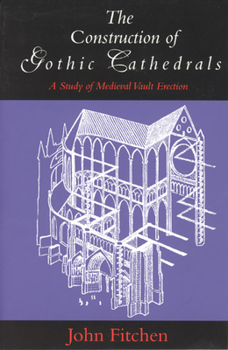The Construction of Gothic Cathedrals: A Study of Medieval Vault Erection
Select Format
Select Condition 
Book Overview
John Fitchen systematically treats the process of erecting the great edifices of the Gothic era. He explains the building equipment and falsework needed, the actual operations undertaken, and the sequence of these operations as specifically as they can be deduced today. Since there are no contemporary accounts of the techniques used by medieval builders, Fitchen's study brilliantly pieces together clues from manuscript illuminations, from pictorial representations, and from the fabrics of the building themselves. "Anyone who has caught the fascination of Gothic Churches (and once caught, has almost necessarily got it in the blood) will find this book enthralling. . . . Clearly written and beautifully illustrated." -A. D. R. Caroe, Annual Review, Central Council for the Care of Churches "Fitchen's study is a tribute to the extraordinary creative and engineering skills of successive generations of mediaeval builders. . . . This study enables us to appreciate more fully the technical expertise and improvements which enabled the creative spirit of the day to find such splendid embodiment." -James Lingwood, Oxford Art Journal "Fitchen, in what can only be defined as an architectural detective story, fully explores the problems confronting the medieval vault erectors and uncovers their solution. . . . This is a book that no serious student of architecture will want to miss." -Progressive Architecture
Format:Paperback
Language:English
ISBN:0226252035
ISBN13:9780226252032
Release Date:April 1997
Publisher:University of Chicago Press
Length:364 Pages
Weight:1.07 lbs.
Dimensions:0.8" x 6.0" x 9.1"
Customer Reviews
5 ratings
Gothic architecture
Published by Thriftbooks.com User , 16 years ago
Chock full of enlightening information and details on how Gothic churches were constructed
Unique book
Published by Thriftbooks.com User , 18 years ago
The only book written on how to build a cathedral. Very informative and helpful to a novice.
Maximum height and maximum light
Published by Thriftbooks.com User , 18 years ago
Good introduction to medieval building techniques. Being a devoted admirer of Gothic cathedrals, this was one of the first books I red about the subject and it served well. If you wish to know why was pointed arch so important, or procedures used to erect butresses or types of scaffoldings used at that times... you will find the answers here. There is one drawback - it seems to me that author was repeating some ideas from the first half of the book in the second one, but still, it deserves 5 stars. Kind regards, Mario.
A Gothic Cathedral version of This Old House
Published by Thriftbooks.com User , 18 years ago
If you want to know about the details of building a Gothic Cathedral this is IT! I only wish the type front was a little bigger and some of the drawings were enlarged. Some of the construction details are pretty much what we are still doing today.
How did they do it?
Published by Thriftbooks.com User , 23 years ago
The builders of Gothic vaults left few clues (written or pictorial) about their actual construction methods. John Fitchen employs induction as well as the skills of a detective to figure out how the vaults were designed and built. Nevertheless, he fails the inquisitive reader at one critical point.Fitchen states that the stone ribs supporting the Gothic vaults conform to a curve called, in mathematics, a catenary. The mathematics of catenary curves was first described by Robert Hooke in the late 1600s. This was no less than 150 years *after* the Gothic builders completed their last work.In the absence of a knowledge of the mathematics of catenaries, how did the Gothic builders discover the *only* rib curvature that was self-supporting?(It's not good enough to say the Gothic builders arrived at the correct catenary curve empirically, that is, by trial and error. There was simply no room for error. All would have come tumbling down.)How did they do it?






